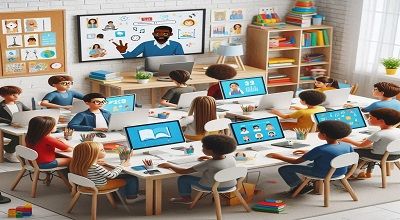E-Learning
E-learning, short for “electronic learning,” refers to the use of electronic technology, particularly the Internet. To deliver educational content and instruction to learners. It has become increasingly popular in recent years and offers numerous benefits, including:
- Accessibility: E-learning makes education accessible to a broader audience, regardless of geographical location or physical limitations. Learners can access course materials from anywhere with an internet connection, making it convenient for people with busy schedules or those who cannot attend traditional in-person classes.
- Flexibility: E-learning allows for flexible scheduling. Learners can study at their own pace and choose when and where to engage with the content. This flexibility is particularly valuable for working professionals, parents, or individuals with other commitments.
- Cost-Effective: E-learning often reduces the costs associated with traditional education, such as commuting, accommodation, and printed materials. Many online courses are more affordable, and some are even free, making education more accessible to a wider range of people.
- Personalization: E-learning platforms can use algorithms and data analytics to personalize the learning experience. Learners can receive tailored recommendations and content that match their interests, skill levels, and learning styles.
- Variety of Learning Resources: E-learning offers a wide range of multimedia resources, including videos, interactive simulations, quizzes, and discussion forums. This variety of content can enhance engagement and cater to different learning preferences.
- Self-Paced Learning: Learners can progress through the material at their own pace, allowing for deeper understanding and mastery of concepts. Those who need more time to grasp a topic can take it, while fast learners can move ahead.
More here…
- Global Collaboration: E-learning enables collaboration among learners from diverse backgrounds and locations. This fosters a global perspective and encourages the exchange of ideas and experiences.
- Continuous Learning: E-learning makes it easier for individuals to engage in lifelong learning. They can acquire new skills, update their knowledge, and stay competitive in a rapidly changing job market.
- Scalability: E-learning is scalable, meaning it can accommodate a large number of learners simultaneously without the need for additional physical infrastructure or resources.
- Real-time Progress Tracking: E-learning platforms often provide tools for tracking learners’ progress and performance. Instructors and learners can monitor their achievements, identify areas that need improvement, and make necessary adjustments.
- Reduced Environmental Impact: E-learning reduces the need for printed materials and commuting, contributing to a lower carbon footprint and less environmental impact compared to traditional education.
- Continuous Updates: Online course content can be updated quickly to reflect the latest developments in a field, ensuring that learners have access to current information and trends.
Final Words
While E-Learning offers numerous benefits, it’s essential to recognize that it may not be suitable for all types of education or all learners. Some people thrive in traditional classroom settings, while others prefer the flexibility and convenience of online learning. The effectiveness of E-Learning also depends on the quality of the content, instructional design, and the level of engagement it offers to learners.
